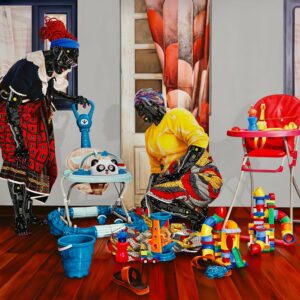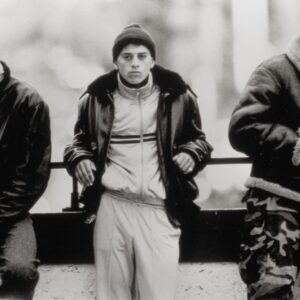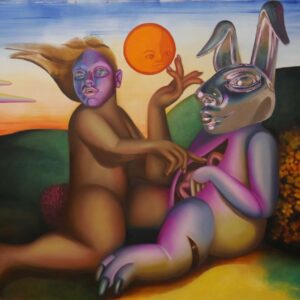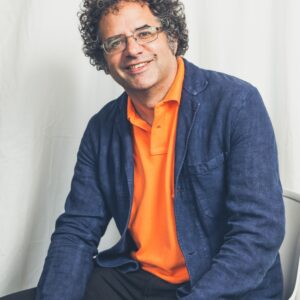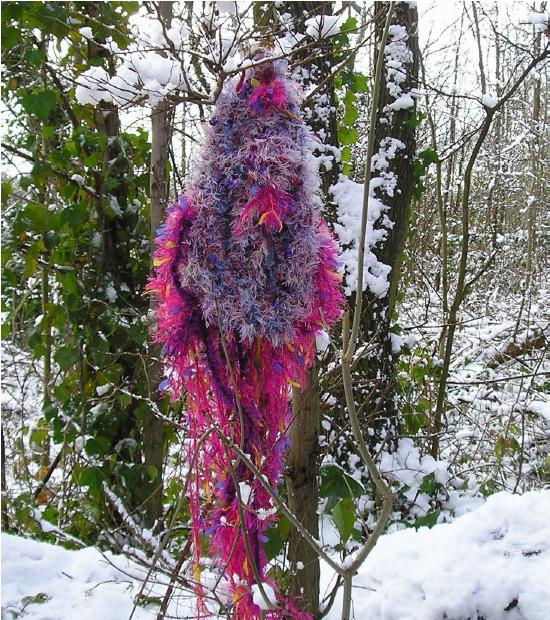
Image:Fiona Carson
Exhibition 26th April- 4 May 2010
Artists: Fiona Carson,Katie Gilman,Ann Haycock,Carole Luby,Sue Manchoulas, Yewande Okuleye.
Fiona Carson: Curator
My work in this exhibition is from the series Sixty by Degrees. The series title refers both to age, and the temperature at which wool felts in a washing machine.
This group of works refers to different kinds of everyday ritual activity; washing clothes, going for walks in the local woods and parks with friends, and knitting. These feminine domestic activities underpin another iconography, that opposes nature to culture and refers to an animistic engagement with nature in the form of birds, insects and sea creatures. Hence the titles Butterfly Fetish, Oceanic Fetish, Cowled
Figure, Owlet. Placing these constructions back into a landscape environment that they were inspired by, changes them, as they are affected by place, time and seasonal change.
Important to the process is the intuitive shaping of the material and
an aspiration to create objects that are ambiguous ‘presences’ in the landscape. In Snowbound, they are grouped together as if they were at an ancient shamanistic site, referencing ancestor worship, proxies for a lost sense of continuity and place.
Statement
I like to tear up, reconstruct, weave, plait, knot, sew, pour and draw. Found, recycled and donated materials can introduce an element of chance or limitation, stimulating the unconscious. Forms emerge which reference the natural world, the body, family dynamics, the unconscious. The work inhabits the spaces between textiles, sculpture
and painting. The visual and tactile senses are dominant but sometimes displaced into unusual materials or subverted by confrontation or warding off as in fetishes and talisman. Look but don’t touch. Touch but don’t look.
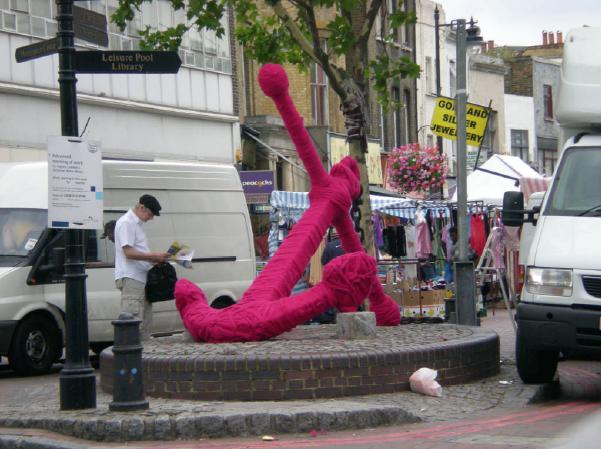
Image:Katie Gilman
Katie Gilman
Katie Gilman was born in Tasmania, Australia and moved to England with her family as a baby. Her work involves an investigation of form, space and place; a search for meaning and understanding articulated through placement,repetition and process which is deeply rooted in her physical and emotional experience of the world as an adopted person.
She is driven by the urge to ritualistically define and explore the formal
qualities of materials, objects and spaces in a quest to understand her own place in the world. This work was originally made for Deptford X 2008. Drawing on the history of rope making in Deptford the artist arduously produced rope by hand from rolls of sleek, shiny black bin bags which were plaited together repeatedly to form chunky, twisted
ropes and coiled and wrapped into a large circular form which was sited on a roundabout in Deptford during the festival. The title of the work 10,597 denoted the distance in miles between Deptford and Tasmania – the birthplace of the artist and final destination of convict boats that sailed from Deptford in the early to mid nineteenth century.
For the Disrupted Narratives exhibition the work is transported approximately four miles along the Thames to the UEL Docklands campus and re-presented in this new context. Re-titled 10,593 to mark this onward journey the work continues the artist’s exploration of connections between site (London Docklands) and her place of birth.
In this case the significance of East India Docks (a short distance from the gallery) revealed itself during research as Abel Tasman the first European to have sight of Tasmania in 1642 named the island Van Diemens Land in honour of the Governor of the Dutch East India Company.
www.myspace.com/katieagilman

Image:Ann Haycock
Ann Haycock
Ann Haycock graduated from UEL in 2006 with a BA (Hons) in Fine Art. She is at present undertaking an MA in Fine Art at University College Falmouth where she is researching everyday items such as clothes and seeds. For the exhibition Disrupted Narrative Haycock is showing two pieces of work, Mound and bite/spit.
For the installation Mound, Haycock has transported from Cornwall, her collection of second hand clothes along with forty packets of cress seeds. She is interested in disturbing our sense of the norm, so instead of soil, the seeds will be planted in amongst the clothes. During the exhibition, Disruptive Narrative, Haycock will invite staff and students to water the heap of clothes thereby enabling the seeds to germinate and grow into a harvest of edible cress. The artist sees Mound as an
interface between people and their reactions to the natural world. Through the care of an inanimate object, made from old clothes which have an unknown history, new life will spring forth, and in so doing, encourage a fresh exchange of ideas.
About a month ago the artist was seen sitting quietly in the corner of the seminar room at University College Falmouth wearing clothes which were covered in cress seedlings. This was the beginning of a performance and film titled bite/spit. Instead of joining in the debate she started to eat the cress when a positive remark was made by one of the MA staff or students with regards to her work.
Negative comments however drew a very different response from the artist, one of biting the cress and spitting it out. The artist’s disruptive, clownish behaviour allowed her to enter into the discussion even though she was not using a spoken language.
Ann Haycock is interested in exploring various channels of communication and combining them with actions and reactions. She says that during daily life these activities often go unnoticed, but when singled out, they take on new and interesting meanings.
www.annhaycock.co.uk
Carole Luby
With three years of making live work since leaving UEL in Carlisle, Newcastle, London, Israel and Turkey ‘under her belt’, Carole luby has an ongoing dialogue with her body within the physicality of time.
For ‘disrupted narratives’ at UEL the body comes alive and finds a temporary place in landscape. The journey, the persistent searching and longing; repetition and the unfulfilled desire for contact is still situated within the body depicting moments in time that represent change and transitions between memory and reality.
My practice attempts to unravel accepted or familiar concepts about inner and outer worlds. Thus the work is a temporal site of rehearsal or potential where infinite solutions might yet be within my grasp whilst making an allowance for unforeseen events to change or challenge the nature of the work. You might call it a kind of alchemical process where my tentative and improvisational activity might emerge as an actualised artwork. Or, perversely it may demystify the practice by revealing the
mess and uncertainty which precedes and is a part of the work itself.
25stratfordgrove.wordpress.com/
nurseluby.blogspot.com/
Sue Manchoulas
Sue Manchoulas’ art seeks to engage with space and sight and sound, to navigate between art and music. Starting with a disjointed personal history, Sue seeks to recreate a sense of a disrupted narration from unrelated materials, including a 10 metre long graphic score, percussionist, Caz Wolfson, playing directly onto the paper manuscript, personal images and the building itself.
From her personal history; Sue was Australian born to a Chinese father and Australian mother, and adopted into an Australian family when 7 years old; the artist is attempting to create a cohesive story. Her work for Disrupted Narratives will be a performance piece, in which a narrative conversation emerges between, building, manuscript and percussionist. Ignoring the disruptions between the materials, and
treating each material with equal narrative importance, the artist plans, by the use of structured improvisation and photos from the past, Sue and the percussionist will beat into submission, the artist’s story.
The theme of the exhibition seems to pivot around textile, texture and text as means of narrative, the manuscript also being text, the text of sound.

Image:Yewande Okuleye
Yewande Okuleye ( M.F.A) Co Curator In Disruptive Narratives Yewande Okuleye explores the notion of identity and belonging through two strands of enquiry.
Hippocampus is an inward looking piece. The impetus for this work comes from anxieties about the reliability and validity of personal memory. How robust are our memories? Yewande Okuleye appropriates the visual language of neuroimaging and re – represents the subjectivities of memory for our meditation.
Looking outwards and in a bid to restore this rupture Caritas attempts to reconnect with shared memories. Facebook is explored as a space
to reconstruct memories and construct new narratives. Although anxieties of the precariousness of memory continue, it is assuaged as friends are invited to fill the gaps of forgetfulness. This act of participation is viewed as a gift, as friends are not obliged to participate. Text generated from this participative process will be used to create artwork for future Disrupted Narrative exhibitions.
www.saatchi-gallery.co.uk/
